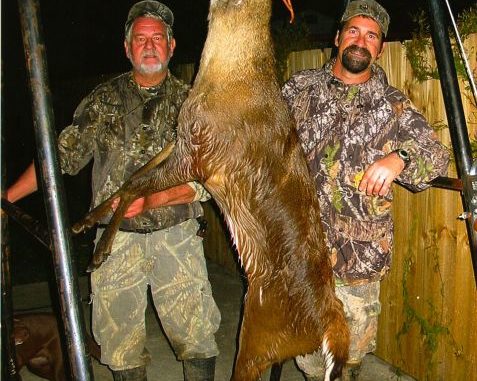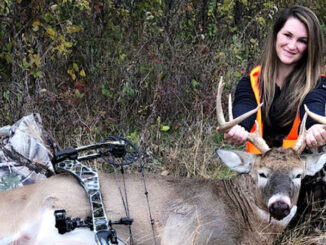
More than 200 deer harvested for first time ever
After reviewing the statistics for the 2014-2015 Atchafalaya Delta WMA deer season, I found it to be a very productive one in terms of total deer taken, 8-point-or-better bucks and another successful youth hunt.
While the deer killed per hunter effort was down slightly from the record set in 2013-2014, it was still a record-breaking season in terms of total hunter efforts and total deer taken at the bowhunting-only WMA.
And for the first time in the history, more than 200 deer were taken in a season, with the final total at 217.
The breakdown for 6-point-or-better bucks taken by the month:
Points 6 7 8 9 10 11
October 1 1
November 2 5 8 4 1 1
December 3 2 5 1
January 1 1 1 2
Totals 6 8 15 6 3 1
The percentage of bucks taken was 57 percent to 43 percent for does. A total of 3,622 hunter efforts resulted in 217 kills, which averages out to one deer kill per 16.7 attempts.
During the youth hunt (shotgun or rifle), 14 deer were taken during two weekends in October, with Lucas Hatch taking the best buck — a nice 7-pointer.
The numbers for the past four deer seasons at the Delta have been fairly consistent:
2011- 176 kills – 3020 efforts – one deer per 17.2 efforts
2012- 160 kills – 2977 efforts – one deer per 18.6 efforts
2013- 173 kills – 2460 efforts – one deer per 14.2 efforts
2014- 217 kills – 3622 efforts – one deer per 16.7 efforts
8-points-or-better by season:
2009 – 25
2010- No info
2011 – 24
2012 – 18
2013 – 17
2014 – 25
Percentage of buck-to-doe kills from 2009 to 2014:
Average – 60 percent bucks and 40 percent does
So what is the 2015-2016 Atchafalaya Delta WMA deer season outlook?
So far, it looks good to me, with solid amounts of rainfall helping to green the area up and provide plenty of browse for the hogs and deer.
But the most important factors are tropical storms, tide surges and hurricanes — any of them can completely change the forecast dramatically.
Drought conditions, though rare in this area, can also have an impact. The last hurricane to impact the Delta was Isaac in 2011. There was actually very little damage, and the numbers for that season reflected it, with 176 deer killed in 3,020 efforts for an average of one deer taken for every 17 efforts.
Another season quite a few years ago — after a relatively weak hurricane pushed in a big tidal surge — I made my first scouting trip that late summer, and I recall seeing water lines and water lilies that were over 6 feet high up in the trees on the Big Island, with a lot of damage to the myrtle bushes from the salt water.
We feared the worst, but even during that season, though the terrain was flattened out or gone in many areas, the hunting was still good.
Apparently there are high enough areas (mostly on the Big Island) for the deer and hogs to ride out the storms and surges. It’s amazing how quickly the area recovers from a significant weather event like that one. So if we can remain storm and tidal surge free for the next few months, I see no reason we can’t have another great season of deer and hog hunting.
The surface drive motor has become the most commonly used mode of transportation when hunting the Delta. It is tailor-made to get into the shallows and over the many sandbars that ring the islands.
Cellphone usage is hit or miss depending on which service provider you use. A GPS is a definite must-have, as more often than not fog will be a factor on early morning and early evening boat rides.
I always highly recommend packing extra clothes and supplies just in case you are forced to spend the night down at the Delta due to tidal conditions or fog.
Hopefully you’ll never need them, but it’s good to be prepared and can save you from a very uncomfortable night. Always check the high and low tides, as they rise and fall dramatically — and even more so in the winter when a cold front come through. I use the tide ranges for Shell Island found here.
I normally start scouting on a limited basis in August, with the goal of finishing up the perimeter islands by mid-September.
I will scout the Big Island up until the end of September, as that island does not open until Nov.1 and we cannot access it at all during the month of October when they have two youth hunts.
Scouting during August and September is pretty grueling for the most part — we try to get there at daylight and shut it down by 10 am at the latest.
Definitely bring a head net and wear long sleeves if you make a scouting trip, as the deer flies are outrageous at that time of the year. Mosquitoes are usually only really bad at daylight and dark. Even more important is to hydrate long before you get there, as dehydration has affected several of my buddies at one time or another. That can be a very serious situation that you want to avoid.
The Delta offers many challenges, which is a big part of the fun to me. Just take the necessary precautions, and you may get to love the place as much as I do.As always, be safe and courteous to all. God bless!


